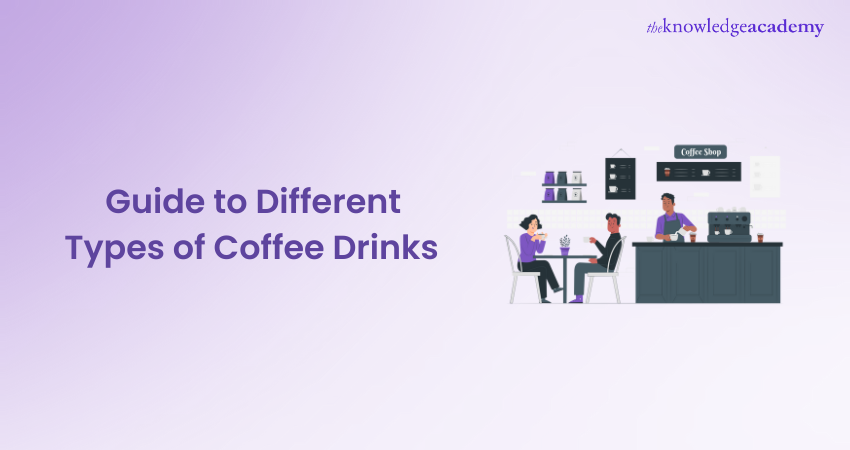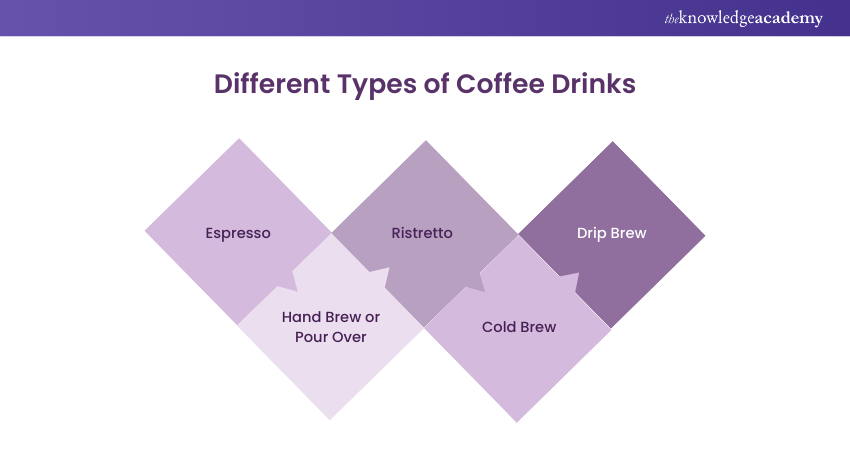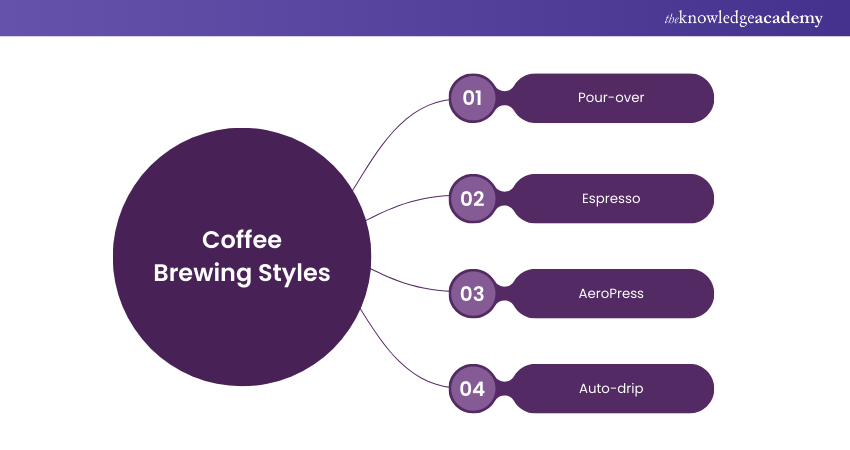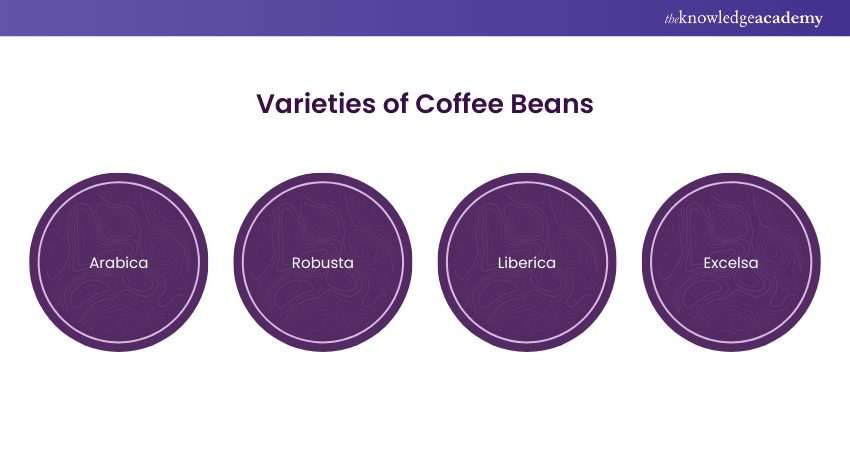We may not have the course you’re looking for. If you enquire or give us a call on +44 1344 203 999 and speak to our training experts, we may still be able to help with your training requirements.
We ensure quality, budget-alignment, and timely delivery by our expert instructors.

Coffee reigns as the world’s favourite beverage, but have you ever wondered why? Beyond its ability to kickstart your mornings, coffee consumption is associated to numerous health advantages, that comprise reducing the risk of Alzheimer’s disease and enhancing cognitive function. With a plethora of choices ranging from the classic Cappuccino to the exotic Cafezinho, coffee lovers are truly spoiled for choice. This blog will delve into the variant Types of Coffee Drinks, defining and demystifying varieties like Cappuccino, Espresso, Latte, and Cold Brew.
The allure of coffee is undeniable, especially among the bustling office-going crowd. But just how deep does this coffee obsession run? Reportedly, approximately 98 million cups of coffee are consumed daily in the UK alone. Tracing back thousands of years, the human relationship with coffee has evolved into a sophisticated craft.
Selecting the perfect beans, blending the right ingredients—each step is culminating in the art of coffee making. Let’s read this blog to look at the efficient Types of Coffee Drinks.
Table of Contents
1) Different Types of Coffee Drinks
2) Different Types of Hot Coffee
3) Different Types of Cold Coffee
4) Unusual and Exotic Types of Coffee
5) Different Types of Brewing Styles
6) Different Types of Coffee Beans
7) Conclusion
The Different Types of Coffee Drinks
Coffee can be brewed, prepared and consumed in several ways. Let’s take a look at some of its different types:

1) Espresso
Americano Coffee is a popular coffee drink that, along with Long Black, originates from a common base—Espresso. Made by forcing pressurized hot water through finely ground and roasted coffee beans (Robusta), Espresso serves as the foundation for many other coffee drinks. This process requires an Espresso machine, resulting in a highly concentrated coffee shot known as Espresso.
Espresso has two different shots; a long shot (2 Oz) and a short shot (1 Oz). It can also be called a double and a single shot, correspondingly.
2) Ristretto
Ristretto is a type of espresso with a sweet flavor, which contrasts with the taste of regular espresso. Making a Ristretto involves using less hot water, enhancing its sweetness. A Ristretto is prepared with a single shot of espresso, resulting in a more concentrated amount of caffeine compared to other types of coffee. For more details on the caffeine content, explore the Amount of Caffeine in Coffee.
3) Drip Brew
Drip Coffee is a classic coffee made by pouring finely grounded Coffee and hot water in a drip Coffee maker. And this machine slowly lets out the mixture into a pot that tastes like heaven.
4) Hand brew or Pour Over
Grounded Coffee is poured into a pot or vessel containing a filter basket, hot water is poured into the filter basket, and then the perfect mixture of brewed Coffee drains out of the filter and into the pot. Although this process is very similar to drip brew, pour-over is even slower as drip uses a machine, and pour-over requires some manual labour.
5) Cold Brew
Cold brew differs from Cold Coffee which is made by pouring hot Coffee into a pot or glass filled with ice cubes. On the other hand, cold brew is made by soaking ground Coffee in water for up to 16 hours.
Different Types of Hot Coffee
Hot Coffee is Coffee made by brewing finely ground Coffee with hot water. Generally, hot Coffees tend to have an intense flavour and smell as the temperature plays a key role.
1) Americano
Americano is an Espresso made by pouring hot water into espresso. It was believed to be created by the American soldiers stationed in Italy during the Second World War. One can make Americano by adding 2/3 of hot water into 1/3 of espresso into a large cup. Ideally, double-shot espresso is preferred for Americano over a single shot. Americano is a one of the kind Coffee that tastes good.
2) Decaf
Decaf or Decaffeinated Coffee is a type where 97 per cent of the caffeine is removed through Decaffeination. Some people are highly sensitive to caffeine, have difficulty drinking regular Coffee, and suffer from side effects like high blood pressure and insomnia. In such cases, Chicory Coffee can be a great alternative, as it is naturally caffeine-free. Decaf allows them to enjoy drinking Coffee without causing any of those issues.
Learn what a perfect roast is and how to achieve perfection in the art of Coffee making with our Basic Barista Course!
3) Flat White
Flat White can be prepared by adding milk without foam and a double espresso shot. Espresso has a strong flavour and would strongly influence the taste of flat white. Although it originated in Australia, it has become a favourite for many people in the UK.
4) Macchiato
Caffe macchiato or Espresso macchiato is a coffee drink made by adding milk or milk foam to a single shot of espresso. It tastes a lot like an Espresso, but what makes it different is the added milk content.
5) Black Coffee
Black Coffee is Coffee made by adding hot water to ground Coffee without milk or cream finely. It has a super strong flavour of Coffee and has quite a bit of kick to it. It is the first thing a lot of people drink in the morning as it has an immediate effect on your senses. Plus, it is very easy to make.
6) Latte
Latte or Latte macchiato is made by pouring an espresso on steamed milk. Latte is a super tasty drink and has a bipolar personality to it. You will get the taste of espresso first, and as you drink further, you will taste the creaminess of the milk.
7) Cafe au Lait
Café au lait is a drink that originated in France and is made by adding warm milk to an espresso shot; however, the ingredients and the ratio may vary depending on where you drink. It is usually prepared in an espresso machine with warm milk and dark Coffee.
8) Cortado
Cortado is yet another espresso-based drink originating from Europe and, in particular, from Spain. It is revered in Latin America, Portugal and Spain. It is prepared by mixing espresso and warm milk in equal quantities.
9) Cappuccino
Cappuccino is made with three main ingredients and one add-on. The three main ingredients are espresso, milk and milk foam, all in equal volume. It is served by mixing these three ingredients and topped with cinnamon or chocolate powder.
Unlock your potential with our Product Management Training - take the first step towards success today!
Different Types of Cold Coffee
Hot Coffee can be good for consumption on cold days but cold Coffee, on the other hand, is good for consumption in summer and when you feel like you need some refreshment. The thing about Making French Press Coffee is that there’s no definite rule on how to make it, and you can add numerous ingredients based on your preference.
Cold or Iced Coffee
Making Cold Brew Coffee involves steeping ground coffee in cold water for an extended period, creating a smoother, less acidic drink. Iced Coffee, on the other hand, is hot coffee that’s cooled down and refrigerated for a while before serving. You can use either black coffee or coffee with milk for iced coffee. Some people also serve it with cold milk and sugar to enhance its taste and flavor.
Iced latte
You can make an Iced latte by pouring an espresso on the ice and then adding cold milk. Froth the milk several times to get an improved texture like a hot latte.
Iced Cappuccino
Iced Cappuccino is made by adding ice to cold milk, then topping it off with an espresso shot and frothed cold milk. Some people add cinnamon to top it off with an attractive finish. It is a much stronger drink than an iced latte.
Take charge of your future with our Facilities Management Training – sign up for our dynamic course!
Unusual and Exotic Types of Coffee
Although most of the coffee drinks we drink today have American and European influences, it is worth remembering that Coffee originated in Ethiopia and people from different cultures like to drink it in their way. Let’s look at some of these unusual and exotic Coffee Drinks!

Cafezinho - Brazil
Cafezinho comes from the largest Coffee exporting country in the world, Brazil, and it means little Coffee. Cafezinho is a much stronger drink than an espresso. Although it is served without milk or cream, it tends to be very thick and sweet.
Vietnamese Coffee
Vietnamese Coffee is also a strong coffee made by mixing hot water and finely grounded Coffee on a metal filter. The Coffee that comes out of the filter is then mixed with condensed milk, giving its unique flavour.
Arabic Coffee
Arabic Coffee, or Qahwa, is an exotic Coffee Drink popular in the Middle East made with saffron and cardamom. It is made from Coffea Arabica beans and is usually served without sugar. Although it has been around for years, the Arabic coffee technique remains the same.
Bulletproof Coffee
Bulletproof Coffee is made by mixing brewed Coffee with unsalted butter and coconut oil. It has a creamy latte on the top and is usually served warm. You can try this simple Bulletproof Coffee Recipe to start your day with a boost of energy!When it comes to Coffee, nothing is more unusual than Irish Coffee. Made using the combination of strong Coffee and a stronger whiskey with cream on the top, it is one of the strangest yet exotic Coffee Drinks.
Choose Your Perfect Cup! See the Key Differences in Tea vs Coffee.
Turn Your Passion for Coffee into a Job! Master These Barista Interview Questions for No Experience.
Different Types of Brewing Styles
Here are some different types of Coffee Brewing Methods to explore:

1) Pour-over
The pour-over method is an ideal approach for unlocking the delicate flavours inherent in a specific coffee variety. It provides a straightforward platform for experimentation, enabling you to precisely adjust the brewing to suit your flavour preferences. With the use of a cone and a filter, you gain mastery over the brewing variables, ensuring you extract the utmost flavour from the coffee grounds.
2) Espresso
Espresso serves as a magnifying glass for your preferred coffee’s traits, intensifying its distinct qualities. Imagine it as examining coffee at a microscopic level. The espresso machine employs pressure to propel water through the coffee grounds, hastening the extraction process and yielding a concentrated “shot” of coffee.
3) AeroPress
The AeroPress stands out as the preferred brewing method for coffee enthusiasts seeking quality brews during their travels. Its powerful and compact design makes it an ideal companion for on-the-go coffee preparation, perfect for serving one or two people. In contrast to the French press, which can leave a residue of grit, the AeroPress delivers a smooth, richly flavoured cup of coffee, because of its fine paper microfilter.
4) Auto-drip
Auto-drip coffee makers are widely recognised and favoured for home brewing. They offer the convenience of preparing coffee swiftly for numerous individuals. A high-quality auto-drip machine, such as the Bonavita 8-Cup model we evaluated, provides an outstanding solution for enhancing your home coffee experience. Its user-friendly interface, robust heating mechanism, and expansive shower head contribute to superior saturation and a more uniform extraction process.
Elevate your expertise with our Logistics Management Training – sign up now and get a competitive edge in the industry!
Different Types of Coffee Beans
Coffee beans come from bush-like coffee plants, with more than 100 different varieties of coffee plants worldwide. But we only consume coffee beans from just two of them. For thousands of years, humans have carefully mastered the art of growing Coffee and found only two Types of Coffee beans to best suit their palette.

1) Arabica
Coffea Arabica is an extremely popular and one of the most widely used Coffee beans. Arabica beans are larger than Robusta beans and have an oval shape with a sharp centre. These beans are adored by Coffee lovers mainly because it tastes a lot sweeter than the other beans and has a fruity chocolate flavour despite strong acidity. Humans have been cultivating Arabica coffee since 1000 BC. Arabica beans are very delicate and only grow at altitudes between 500 to 2500 meters. It requires specific weather conditions to grow.
2) Robusta
Robusta has more caffeine but lower acidity, which is one of the reasons why it is less sweet than Arabica. It has a strong and rich flavour, making it perfect for making espressos. Apart from this, Robusta is a tough, hardy plant that can ideally grow at an altitude of fewer than 1000 meters. And they are least likely to be impacted by pests and diseases. Robusta beans are much smaller than Arabica beans, have a circular shape, and look pale in colour.
3) Liberica
The Liberica coffee bean is a rare find, distinguished not only by its larger size compared to other varieties but also by its distinctive asymmetrical shape. It’s the only coffee bean known for such an unconventional form. The aroma of Liberica beans is equally remarkable, offering a complex bouquet that is often described as a harmonious blend of smoky, fruity, and floral notes, enhancing the overall Coffee Aroma experience.
4) Excelsa
The Excelsa bean, often found in Southeast Asia and accounting for a mere fraction of global coffee production, presents a tart and fruity flavour that is reminiscent of a light roast. Its complex profile, featuring a blend of both tart and roasty notes, challenges the palate and defies conventional coffee expectations. This unique taste, coupled with its rare occurrence, makes Excelsa a sought-after variety among Coffee Aficionados seeking an unconventional experience.
Conclusion
If you are a Coffee lover, passionate about drinking and making Coffee the right way, then you would’ve enjoyed this blog about all the Types of Coffee Drinks. You would’ve also learned about some exotic and unusual Coffee Drinks. And if you're in the mood for a coffee-inspired dessert, a Coffee and Walnut Cake Recipe is a delicious way to indulge your coffee cravings.
Take the next step in your career with our Supply Chain Management Training – register today!
Frequently Asked Questions
How did the Cappuccino get its Name?

The cappuccino got its name from the Capuchin friars, whose brown robes resembled the coffee's colour. The word "cappuccino" means "little hood" in Italian, reflecting the friar's distinctive hoods.
What is the Popular Coffee Variety?

Arabica is the most popular coffee variety, known for its smooth, mild flavour and lower caffeine content compared to Robusta. It's widely grown and favoured for its superior taste.
What are the Other Resources and Offers provided by The Knowledge Academy?

The Knowledge Academy takes global learning to new heights, offering over 3,000 online courses across 490+ locations in 190+ countries. This expansive reach ensures accessibility and convenience for learners worldwide.
Alongside our diverse Online Course Catalogue, encompassing 19 major categories, we go the extra mile by providing a plethora of free educational Online Resources like News updates, Blogs, videos, webinars, and interview questions. Tailoring learning experiences further, professionals can maximise value with customisable Course Bundles of TKA.
What is The Knowledge Pass, and How Does it Work?

The Knowledge Academy’s Knowledge Pass, a prepaid voucher, adds another layer of flexibility, allowing course bookings over a 12-month period. Join us on a journey where education knows no bounds.
What are Related Courses and Blogs Provided by The Knowledge Academy?

The Knowledge Academy offers various Industry Trainings, including the Facilitation Skills Training, Basic Barista Course, and SCADA Training. These courses cater to different skill levels, providing comprehensive insights into Principles of Facilitation.
Our Business Skills Blogs cover a range of topics related to Industry Management, offering valuable resources, best practices, and industry insights. Whether you are a beginner or looking to advance your Business skills, The Knowledge Academy's diverse courses and informative blogs have got you covered.
Upcoming Business Skills Resources Batches & Dates
Date
 Basic Barista Course
Basic Barista Course
Fri 25th Apr 2025
Fri 20th Jun 2025
Fri 29th Aug 2025
Fri 31st Oct 2025
Fri 19th Dec 2025






 Top Rated Course
Top Rated Course



 If you wish to make any changes to your course, please
If you wish to make any changes to your course, please


